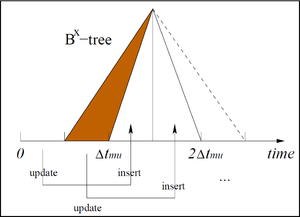
Bx-tree
In computer science, the Bx tree is a query and update efficient B+ tree-based index structure for moving objects.
Index structure
The base structure of the Bx-tree is a B+ tree in which the internal nodes serve as a directory, each containing a pointer to its right sibling. In the earlier version of the Bx-tree, the leaf nodes contained the moving-object locations being indexed and corresponding index time. In the optimized version, each leaf node entry contains the id, velocity, single-dimensional mapping value and the latest update time of the object. The fanout is increased by not storing the locations of moving objects, as these can be derived from the mapping values.
Utilizing the B+ tree for moving objects
As for many other moving objects indexes, a two-dimensional moving object is modeled as a linear function as O = ((x, y), (vx, vy), t ), where (x, y) and (vx, vy) are location and velocity of the object at a given time instance t, i.e., the time of last update. The B+ tree is a structure for indexing single-dimensional data. In order to adopt the B+ tree as a moving object index, the Bx-tree uses a linearization technique which helps to integrate objects' location at time t into single dimensional value. Specifically, objects are first partitioned according to their update time. For objects within the same partition, the Bx-tree stores their locations at a given time which are estimated by linear interpolation. By doing so, the Bx-tree keeps a consistent view of all objects within the same partition without storing the update time of an objects.
Podcasts:

